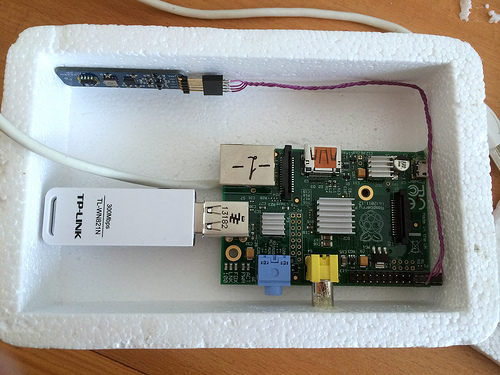
When [Ioannis] received some high resolution LCD’s in a tattered foam box, he posed to himself a most interesting question – Should he throw the foam box away, or use it as a container for a project? Fortunately for us, he decided on the latter and threw together a very capable weather station!
Having only an hour to spare, [Ioannis] grabbed a Raspberry Pi, WiFi USB stick and a camera module and went to work. He mounted the camera module to the foam lid using a highly advanced technique, and soldered a cable that would power the device directly to D17 – a Zener diode that sits on the bottom of the board.
For the weather data, he’s using another design of his – the Sensor Stick. This nifty device — which we featured over the weekend — is about the size of a stick of chewing gum, and sports an array of sensors including the popular BMP085, which can measure pressure and temperature .
He wraps up everything using open source software to get the data from the weather station. Pretty impressive for an old foam box and an hours time! This would be an interesting start to a home automation system. Connect it to motorized windows and/or a sprinkler system and he’s on his way to claiming The Hackaday Prize.















ESD?
Extreme Static Discharge ?
My thoughts exactly!
Doesn’t insulating the (three) thermometers with Styrofoam kinda defeat the purpose of a weather station? other than that though, +1 for the upcycling of the box!
Seeing he keeps the thing inside on the heater I guess it makes some,weird, sense :)
And didn’t that sensor stick have a gyro and accelerometer? Maybe he should make a tremor and earthquake detector from it instead.
Me too.
Is Styrofoam conducive to producing static electricity which would damage the static sensitive parts on the Pi and the other naked boards?
Yup, putting a thermometer in a styro box with a hot object. Should be accurate. ;p
Sometimes you need to know what the weather is going to be like in styrofoam boxes in your area on a given day.
Ahh, semiconductor microclimates!
Haha!!! Exactly! As I told, the position of the sensors is the recommended one! You will measure the heat of the RPi!
I was not willing to do the epic weather station! I was willing to do something with the box!
*As I told, the position of the sensors is NOT the recommended one!
I forgot the not before!!!! :)
So, apart from the foam box, it’s a great weather station?
And yes, ESD is a huge problem with foam materials! But again! I was playing with the box and nothing more! I am not going to operate the Pi from there 24/7!
First… ANY insulating material is a potential source of ESD. Second, if it is all inside the box, just what is it going to flow through to get to ground?
The world has become just a little ESD paranoid and the industry thrives on ignorance.
power supply?
Insulating means an electric charge cannot easily move along or through it. Thus you may have a region of the material that obtains a bigger charge than another region, even if the two are in the same contiguous piece of material. A conductive object placed between them (in this case, the Pi) provides an easier path for charge to flow and equalize than the material surface itself, so the charge flows through it. Bam, ESD, no ground path required.
Paranoid? Nah. They just don’t want to incur the massive rework costs and customer dissatisfaction from early product failures. A little caution goes a long way.
No…
Just ‘no’? That’s not very helpful. What part are you contesting, and why?
Beside already mentioned temperature isolation (RPi would be fine even without radiators btw) & ESD issues – Why did he solder power supply directly to zener diode? couldn’t he just use goldpin GND/5V?
rpi schematic for reference:
http://www.raspberrypi.org/wp-content/uploads/2012/10/Raspberry-Pi-R2.0-Schematics-Issue2.2_027.pdf
Yes, I could do that! But I did it like that because… well… I like it a lot more like that!
You will have exactly the same functionality if you use for power the GND and +5V of the RPi pin header!